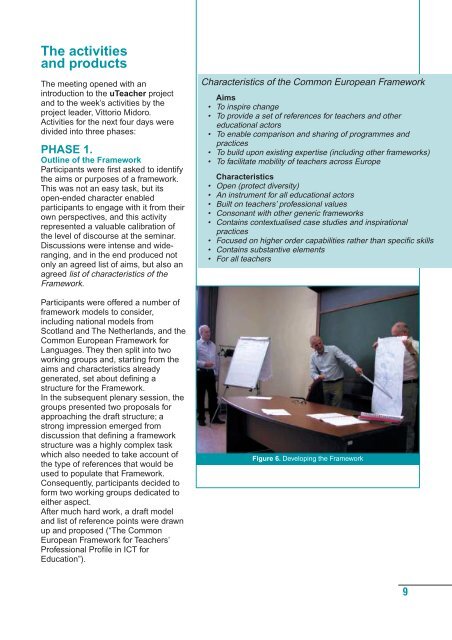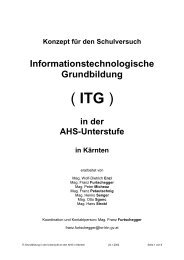teachers' professional profile in ICT for education
teachers' professional profile in ICT for education
teachers' professional profile in ICT for education
Create successful ePaper yourself
Turn your PDF publications into a flip-book with our unique Google optimized e-Paper software.
The activities<br />
and products<br />
The meet<strong>in</strong>g opened with an<br />
<strong>in</strong>troduction to the uTeacher project<br />
and to the week’s activities by the<br />
project leader, Vittorio Midoro.<br />
Activities <strong>for</strong> the next four days were<br />
divided <strong>in</strong>to three phases:<br />
PHASE 1.<br />
Outl<strong>in</strong>e of the Framework<br />
Participants were first asked to identify<br />
the aims or purposes of a framework.<br />
This was not an easy task, but its<br />
open-ended character enabled<br />
participants to engage with it from their<br />
own perspectives, and this activity<br />
represented a valuable calibration of<br />
the level of discourse at the sem<strong>in</strong>ar.<br />
Discussions were <strong>in</strong>tense and widerang<strong>in</strong>g,<br />
and <strong>in</strong> the end produced not<br />
only an agreed list of aims, but also an<br />
agreed list of characteristics of the<br />
Framework.<br />
Participants were offered a number of<br />
framework models to consider,<br />
<strong>in</strong>clud<strong>in</strong>g national models from<br />
Scotland and The Netherlands, and the<br />
Common European Framework <strong>for</strong><br />
Languages. They then split <strong>in</strong>to two<br />
work<strong>in</strong>g groups and, start<strong>in</strong>g from the<br />
aims and characteristics already<br />
generated, set about def<strong>in</strong><strong>in</strong>g a<br />
structure <strong>for</strong> the Framework.<br />
In the subsequent plenary session, the<br />
groups presented two proposals <strong>for</strong><br />
approach<strong>in</strong>g the draft structure; a<br />
strong impression emerged from<br />
discussion that def<strong>in</strong><strong>in</strong>g a framework<br />
structure was a highly complex task<br />
which also needed to take account of<br />
the type of references that would be<br />
used to populate that Framework.<br />
Consequently, participants decided to<br />
<strong>for</strong>m two work<strong>in</strong>g groups dedicated to<br />
either aspect.<br />
After much hard work, a draft model<br />
and list of reference po<strong>in</strong>ts were drawn<br />
up and proposed (“The Common<br />
European Framework <strong>for</strong> Teachers’<br />
Professional Profile <strong>in</strong> <strong>ICT</strong> <strong>for</strong><br />
Education”).<br />
Characteristics of the Common European Framework<br />
Aims<br />
• To <strong>in</strong>spire change<br />
• To provide a set of references <strong>for</strong> teachers and other<br />
<strong>education</strong>al actors<br />
• To enable comparison and shar<strong>in</strong>g of programmes and<br />
practices<br />
• To build upon exist<strong>in</strong>g expertise (<strong>in</strong>clud<strong>in</strong>g other frameworks)<br />
• To facilitate mobility of teachers across Europe<br />
Characteristics<br />
• Open (protect diversity)<br />
• An <strong>in</strong>strument <strong>for</strong> all <strong>education</strong>al actors<br />
• Built on teachers’ <strong>professional</strong> values<br />
• Consonant with other generic frameworks<br />
• Conta<strong>in</strong>s contextualised case studies and <strong>in</strong>spirational<br />
practices<br />
• Focused on higher order capabilities rather than specific skills<br />
• Conta<strong>in</strong>s substantive elements<br />
• For all teachers<br />
Figure 6. Develop<strong>in</strong>g the Framework<br />
9



